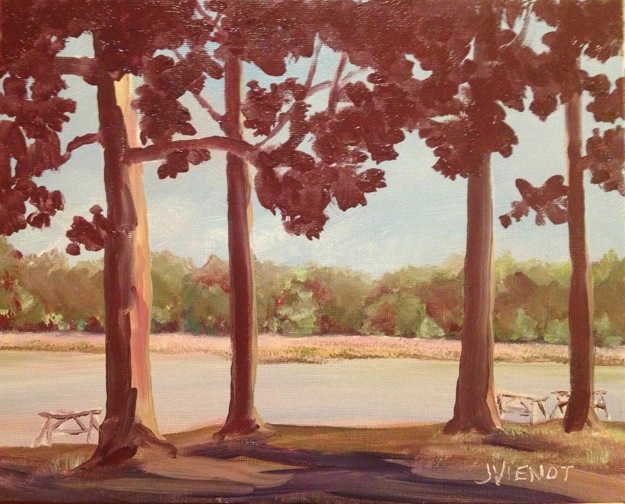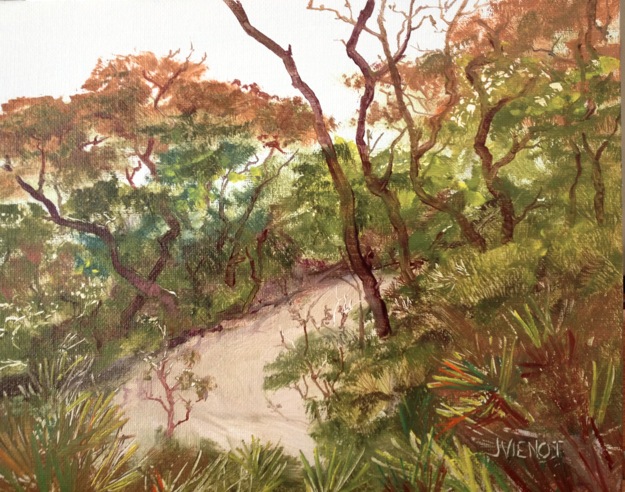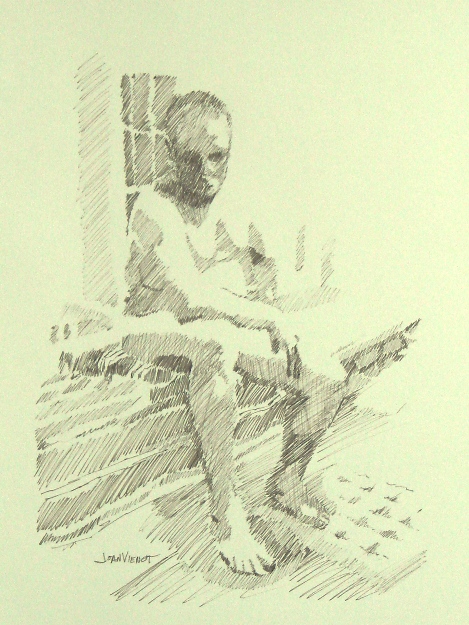

Every geographic area has its plagues, I suppose. Here in Northwest Florida, our plagues are yellow flies from mid-May through the middle or end of June, and in late summer or fall, dog flies. I react badly to yellow fly bites, getting a huge hive within minutes. If I put a good anti-inflammatory cream on the bite right away, I will avert a reaction. My plein air painting backpack is stocked with a strong repellent, and the best anti-inflammatory salve I can find. I used both today.
We painted at Eden Gardens State Park, which is just a hop and a skip from my home. I cajoled my dear friend, Lori Ceier, into coming out and painting with us. Lori is the producer of my favorite website for local activities, www.waltonoutdoors.com. Lori claims not to be an artist but I think what she really means is that up ’til now, she has preferred photography to painting.

Having recently completed my training as a Reiki Master, and thoroughly convinced of the Law of Attraction, nevertheless, during yellow fly season, I still cover most of my skin with clothing and put repellent on what’s left. I fared pretty well, until the last half hour when the frustrated flies were fairly spitting their venom. We all stopped painting soon then, and went to the screened pavilion for our critique. Lori took a series of Photos showing the progression of my painting, and posted them on her Facebook page for WaltonOutdoors.com.
Plein air critique is interesting. We each put our paintings up in a row and everyone ooo’s and ahhh’s and then each artist talks about their piece, the challenges they faced, what their intentions were, etc., and then the group might offer a suggestion for this effect or for that one. If an artist has had enough of that fun, he or she might end the suggestions by saying thank you , y’all have given me a lot of ideas, and then we move on to the next piece. Generally though, these are what I would call “soft” critiques, in that all of the artists are so encouraging — no one ever tells you that maybe you should take up sculpture or some other art form.
I felt so brave when I was painting, daringly putting a muted purple in the trees in the background, and a bright purple in the shadows in the foreground, and painting the silhouette of the foreground tree leaves a deep red-violet. But when I look at the painting from any distance, the purples just become dark values, not daring at all! My intention was to paint the background trees and grasses with brighter colors and more detail, and the foreground with broader brush strokes and less detail. I think everything turned out more or less as I had hoped, except for the color of the water. When I put the rich red-violet trees and shadow patterns in the foreground, the water of the bayou in the middle-ground, which I had painted a light pinkish blue, became more muted by comparison, almost a light gray.
In general, I’m pleased with the overall impression of looking out at the bayou through very large trees. The barely visible picnic tables show the scale of the trees.
———————————
Most of my paintings and images are available for purchase. Contact me if you are interested. — Joan Vienot











 I was privileged to paint plein air beside my artist friend
I was privileged to paint plein air beside my artist friend 
















 This week in Figure Drawing at
This week in Figure Drawing at 

